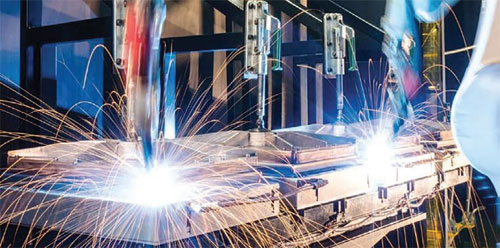By Brice Wallace
While workforce shortages and supply chain issues resulting from the COVID-19 pandemic currently plague Utah’s manufacturing sector, the outlook in the near term could remain grim.
Speakers at a recent Future of Utah Manufacturing Summit indicated that recovering from the pandemic could take a while, in part because of the unpredictability of its length and impacts on an industry that accounts for 7 percent of Utah’s workforce and affects one-fourth of its GDP.
The summit came after the release of an in-depth economic study by the Utah Industry Resource Alliance (UIRA) and the Utah Advanced Materials and Manufacturing Initiative (UAMMI) of the pandemic-induced recession on the state’s manufacturers. It indicated a dichotomy, with some manufactures facing steep sales declines and others unable to keep up with demand.
“In the study that we just completed as the UIRA looking at the economic trends underlying that the Utah manufacturing industry, we are in what should be our recovery phase, but now with this third resurgence of the pandemic, it’s certainly setting things back,” said Tulinda Larsen, an economist and executive director of UAMMI.
“It looks like we will have a much longer recovery — probably 2023, maybe even out to 2025 — before we can get back up to the 2019 levels of production and revenue.”
The dichotomy includes companies “just burning up, they can’t keep up,” she said, noting companies producing bicycles and skis or involved in bricklaying. It also includes companies like those in aerospace and oil and gas that “are just way down.”
“I think the biggest challenge, hands down, for our industry is finding our way out and back to recovery,” Larsen said.
June Chen, managing partner at LDD Partners, a boutique investment banking firm, and managing partner at Mountain Pacific Venture Partners, serving early- and growth-stage medical device companies, said COVID has created both opportunities and challenges for Utah’s manufacturers. One medical device distribution company, she said, would have had to close its doors had it not switched to distributing personal protective equipment (PPE).
“I think the biggest challenge of 2021 is going to be to predict where the trends will go,” Chen said. “The unpredictability of COVID and what it’s going to bring is sort of like looking into a crystal ball and figuring out, well, what’s the next manufacturing trend related to PPE or medical devices that we would be able to jump on now and be just-in-time-for for 2021?”
Johnny Ferry, vice president of business development for Honeyville, a co-manufacturer of branded consumer dry goods, said many of his company’s projects in March were “in incubation,” including those that normally take six months to two years to complete. But companies relying on Honeyville suddenly wanted projects in production immediately while also boosting the number of their projects.
“I think those [manufacturers] who are in that mode and succeeding are those who have been able to respond and be dynamic and flexible with the demand that either is there suddenly or has dropped off and then you swerve and you work on the next project,” Ferry said.
David Winter, in charge of worldwide product development and of engineering and manufacturing at the Clearfield operations of Lifetime Products, said demand for his company’s products softened in March and some temporary workers were let go as a result. Three weeks later, “it started taking off like crazy,” and Lifetime has been in a constant hiring mode since then — unable to fill 100 production positions at the time of the summit.
“Next year, just knowing this year’s been a significant jump [in business], we’ve got to be careful not to add too much capacity because we don’t know what’s coming in the future,” Winter said. “Is it going to back down to what it was before, or are we going to add on from there?”
Speakers said manufacturers are facing a variety of challenges, including a shortage of workers, a situation exacerbated by some of them wanting to remain at home or the exodus of women employees; and issues with supply chains.
“We literally have product that we’ve jumped through hoops to build and made it through all of our challenges, and it’s sitting in our warehouse because we can’t get trucks to show up to take it out,” Winter said, noting also a difficulty in getting trucks to bring in the raw materials Lifetime needs. “Shipping has become a huge issue for our company.”
But Ferry said that in the current environment, manufacturers need to recognize any opportunities that present themselves. Other speakers said now is the time to invest in employees, if not in higher wages then by providing them with meaningful work and by management showing appreciation for them. Chen suggested that companies focus on areas that will be more resistant to recessions or geopolitical events.
“Certainly, life sciences and medical devices have historically survived downturns with less impact,” Chen said, “and I think those are going to be critical to long-term prosperity here in Utah.”
Larsen expressed optimism that coping with the pandemic-prompted recession will lead to creativity, just like the global financial crisis in 2008 spawned several successful companies.
“Recessions like this one and the pandemic are the catalysts for innovation,” she said. “We really can look at the silver lining as to innovation finding us the way out and back into a growth economy.”








